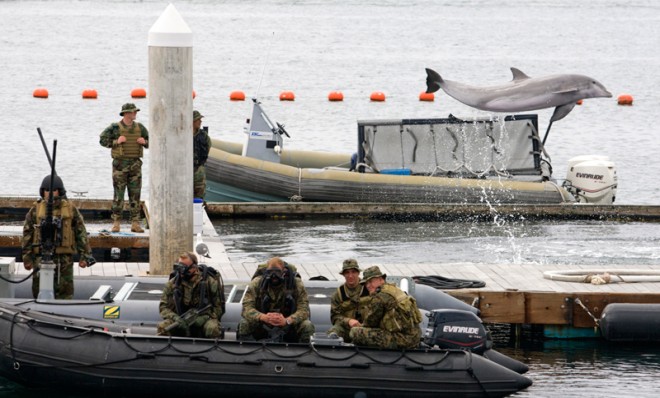6 unusual ways animals have been used in warfare
Rotting cows, combat-trained German shepherds, and bomb-sniffing dolphins... Oh my

1. Dogs
Why they were used: Their acute sense of smell
Equipment: Radios and bulletproof armor
The Week
Escape your echo chamber. Get the facts behind the news, plus analysis from multiple perspectives.

Sign up for The Week's Free Newsletters
From our morning news briefing to a weekly Good News Newsletter, get the best of The Week delivered directly to your inbox.
From our morning news briefing to a weekly Good News Newsletter, get the best of The Week delivered directly to your inbox.
Of all the spellbinding stories splintered off from SEAL Team 6's killing of Osama bin Laden, one that grabbed the internet's finicky attention surrounded a combat-ready German shepherd. Typically used to sniff out improvised explosives that humans couldn't otherwise detect, the military's pooches are as indispensable as they are terrifying to come across in battle. Unfortunately, the rumor concerning the killer dog's flesh-ripping titanium teeth may be overstated; military sources tell Wired's Danger Room that a metal grill just means a dog needed some dental work due to health problems.
2. Dolphins
Why they were used: Bomb detection
Equipment: Underwater cameras
A free daily email with the biggest news stories of the day – and the best features from TheWeek.com
The big, exciting international story this week was that a small pod of military-trained dolphin killing-machines somehow escaped their Ukrainian captors, and were now out on the lam, replete with blades and pistols strapped to their heads. In other words: If you spot a Killer Flipper, watch out! Unsurprisingly, it now appears the reports were more than a little sensationalized, and the happy-go-lucky mammals may not even be missing at all. That said, the current prerogative of the U.S. military is to retire dolphins from their bomb-sniffing duties and replace them with submersible, explosive-detecting robots. Suffice to say: Dolphins, while indeed awesome, are probably the least of your worries... even the murderous kind.
3. Elephants
Why they were used: They're really big and can stomp on things
Equipment: Sometimes they had archers on their backs
"War elephants were the tanks of their time," says Mental Floss. In the ancient world (think Mesopotamia and India), the hulking brutes' thick hides were ideal for repelling flimsy arrows. The beasts' tremendous size and trumpeting battle cries were enough to send enemy horses and their riders scampering around chaotically. To boot, archers could sit atop the fearsome pachyderms and rain down arrows from high above.
4. Pigs
Why they were used: To scare off elephants
Equipment: N/A
The mighty elephants had their kryptonite, though: Pigs. As Roman scholar Pliny the Elder tells it, "Elephants are scared by the smallest squeal of the hog." Sometimes — in what would obviously be seen as cruel and unusual warfare today — anti-elephant piggies were covered in tar, set on fire, and unleashed into battle to stir chaos. Mmmm. Barbecue.
5. Bats
Why they were used: Ever hear the term "bat-bomb"?
Equipment: Explosives
During World War II, soon after the attack on Pearl Harbor, the United States considered unleashing a swarm of bomb-carrying bats on Japan's cities. According to the Feb. 16, 1948, issue of Life Magazine, "Operation X-ray" entailed parachuting large containers of bat-bombs down onto the unsuspecting enemy. "The bats would be released to circle down and crawl into the cracks and crannies of buildings where their incendiary capsules would explode. Thousands of fires simultaneously and a bat-beleaguered town would be burned to the ground." The plan never actually materialized, however, says Life. "No other explanation was ever offered. Perhaps by that time the top government officials had reason to believe that another and even more deadly weapon would soon be ready."
6. Rotting cows
Why they were used: For their noxious fumes
Equipment: Deadness
When carrying out sieges, medieval armies would often use trebuchets (ancient catapults) to launch heavy missiles into enemy castles, spreading flames and causing widespread destruction. Sometimes, to speed up the siege process — which could take months, if not years — savvy war-wagers would launch the rotting carcasses of cattle over castle walls in what's now seen as a primitive form of biological warfare.
-
 A lemon-shaped exoplanet is squeezing what we know about planet formation
A lemon-shaped exoplanet is squeezing what we know about planet formationUnder the radar It may be made from a former star
-
 Political cartoons for January 4
Political cartoons for January 4Cartoons Sunday's political cartoons include a resolution to learn a new language, and new names in Hades and on battleships
-
 The ultimate films of 2025 by genre
The ultimate films of 2025 by genreThe Week Recommends From comedies to thrillers, documentaries to animations, 2025 featured some unforgettable film moments